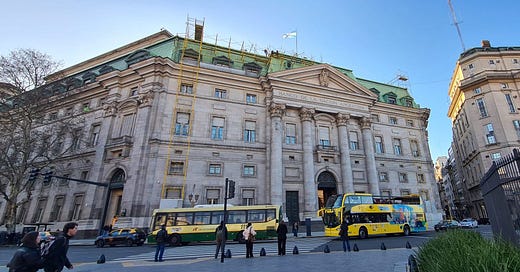How I Stumbled Into Argentina's Century-Old State Banking Disaster
Reflections on Argentina's Past and Present from the Caves of Buenos Aires (Part 3)
Just the other day, the missus, the kids, and I were meeting some friends for lunch at a local restaurant. It’s a cozy spot in Hotel Fierro on Soler, a street in Palermo. I highly recommend the asado next time you’re in Buenos Aires.
My friend Tomas ended up picking up the tab with crypto (yes, there are many places where you can do that in Buenos Aires). But since he had just arrived and didn’t have any cash, I insisted on paying him back. Below is a photo of us settling up for the meals, which barely cost $120 for seven people (including three small kids).
Now, if you didn’t know any better, seeing the bundles of cash on the table, you’d think I’m paying for something far less innocent than a couple of steaks and some ice creams. That’s what inflation does—it turns you into an apparent criminal!
It was right then and there that I realized I needed to visit the Banco Central de la Argentina—the Central Bank of Argentina... The place from which so much misery has spread to the people of Argentina.
The missus and the kids didn’t seem to mind, so off we went.
The Wrong Bank
The moment we got out of our Uber, I realized we’d arrived at the wrong bank. Apparently, I’m not very good at entering info for Uber orders… or paying attention during the ride.
So, instead of taking us to the Banco Central de la Argentina (BCRA), our driver brought us to the Banco de la Nación Argentina (BNA), or Banco Nación for short. Here’s a picture of it below.
Contrary to what the name suggests, the “Bank of the Argentine Nation” isn’t a central bank. It doesn’t manage the country’s currency, oversee the banking system, or handle monetary policy—the BCRA does.
Meanwhile, BNA is—and this may be hard to wrap your head around since the U.S. doesn’t have a direct equivalent—a state-owned commercial bank.
If you’re confused, imagine if the Fed and your local bank had a baby, and that baby grew up to be a shopaholic with a habit of dipping into other people's wallets when they're not looking.
Trust me, I’m not overkilling the analogy here.
Besides the fact that it’s generally not a great idea for the state to own anything, “state-owned commercial bank” is a contradiction in terms. Banking needs market discipline and a profit motive, while state ownership usually focuses on political goals and lacks real accountability.
Politicians use these institutions as tools to push their economic policies, regardless of the bank's financial health, sound banking practices, or the damage it might cause to the economy.
BNA’s track record is a testament to that.
BNA Never Sleeps... But for All the Wrong Reasons
While its main mission is to “provide financial services that support Argentina’s economic development,” the BNA has strayed far from this goal throughout its 130-year history.
Since Juan Perón's era in the 1940s and 50s, the bank has pretty much been the financial arm of Peronist socialist policies. And as such, it has done it all.
The BNA poured money into programs and industries beloved by Peronist governments, economic viability be damned. It manipulated Argentina's crucial agricultural sector, favoring political cronies over market demands. The bank mismanaged pension funds (nationalized in 2008) and, rather than maximizing returns for pensioners, even used them to finance government deficits. Bloated workforce, ghost jobs, inefficiency, unfair competition in the banking sector—you name it, the BNA is the poster child for all of it.
And corruption? Oh man, where do I begin? Here are just a few bullet points highlighting some of the BNA's hits in the fraud department:
In 1994, the IBM-BNA scandal erupted when it was revealed that IBM executives had paid $37 million in bribes to BNA officials to secure a $250 million contract to upgrade the bank’s IT systems.
In 2015, the BNA was embroiled in a political lending scandal, accused of dishing out sweetheart loans to businesses tied to the ruling party.
In 2021, the bank came under fire for granting large, unsecured loans to politically connected agricultural companies. These loans, issued without proper vetting, led to defaults and significant losses for the BNA.
In short, the BNA’s history has been like a never-ending telenovela, with the Argentine people's money as the main character destined for a tragic end.
Again, for those of us in the U.S., it might be hard to grasp how a government-run bank can have so much power with so little accountability.
Fortunately, Argentina’s new president, Javier Milei, sees the BNA as a dumpster fire that needs to be put out. In December 2023, the month he took office, Milei signed a Decree of Necessity and Urgency (DNU) that repealed the law blocking BNA’s privatization. Even though Congress has tried to take it off the list of entities to be privatized, Milei’s administration is pushing ahead with the privatization plans anyway.
Long Live Freedom, Damn It!
Lau Vegys
P.S. If you’re wondering why you should care about what’s happening in a remote country in South America, Argentina is like that Fortune 500 company that’s now a penny stock. The parallels with the U.S. are striking, and its story should be taught in every American school. But it’s not.





Lau..............It is going to take a long time for the new regime to turn things around, and one can never totally trust political leaders because of it. History always comes back around, but the people do not remember it. I personally feel that it is too soon for tourism there, and our dollar just goes into the pockets of the crooks, just like here. I think people need to hunker down , and I know the next few months in the US are going to be perilous. I moved to a red state from California, and feel a lot more relaxed. I have been all over the world, and the political leaders now are the worst there have ever been in Europe. There is soon going to be social unrest all over the place. Stay safe!